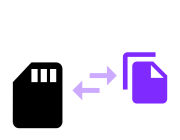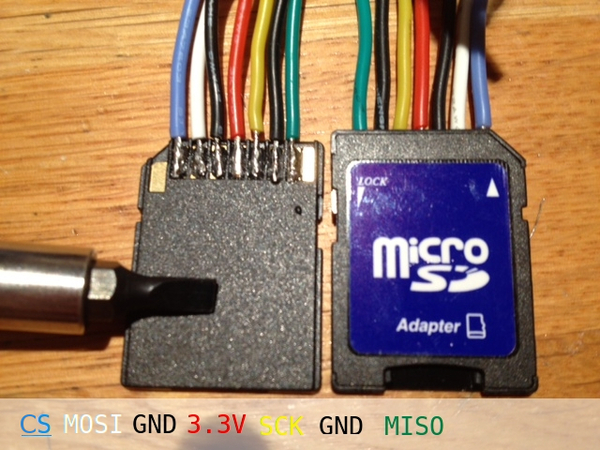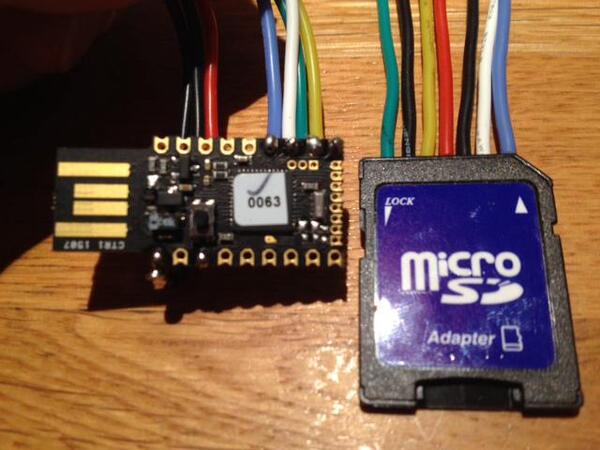
File IO and SD cards
To access files from Espruino (if you're not getting them from the Internet) you'll need an SD card.
On the original Espruino board there's a Micro SD card slot built-in,
or on the Espruino Pico or other boards you'll have to wire a card up externally and then
tell Espruino about it with E.connectSDCard
(see Wiring below).
Espruino has two main forms of File IO available:
FS Library - Simple Node.js-compatible File IO
The fs library allows you to read directories, read, write, stat and delete files. See here for more details about the specific functions.
We've tried to keep it a lot like the Node FS Library however
note that while Asynchronous functions exist (like fs.readFile) they are not currently asynchronous
and behave the same way as their ...Sync equivalents.
Read directory contents
var files = require("fs").readdirSync();
for (var i in files)
console.log("Found file "+files[i]);
Read and write files
require("fs").writeFileSync("hello.txt", "Hello World");
console.log(require("fs").readFileSync("hello.txt")); // prints "Hello World"
require("fs").appendFileSync("hello.txt", "!!!");
console.log(require("fs").readFileSync("hello.txt")); // prints "Hello World!!!"
However, with the exception of appendFileSync, these functions only allow you to act on whole files. This means that you will quickly exhaust Espruino's RAM when loading larger files.
E.openFile - Stream File IO
While we'd have liked to keep a node.js-compatible Filesystem stream API, Node's implementation just didn't make sense on a Microcontroller.
Instead we have developed our own simple API. Just use
E.openFile to open a file. This
returns a File Object, which has functions
such as read, write and seek on it.
For example the following would open a file, get one byte out of it, and then write to an analog (PWM) output 10 times a second.
var f = E.openFile("data.raw","r");
setInterval(function() {
var val = f.read(1).charCodeAt(0);
analogWrite(A0, val/256);
}, 100);
Or the following would take a series of readings and write them as a comma-separated file:
var f = E.openFile("data.csv","w");
setInterval(function() {
var readings = [
analogRead(A0),
analogRead(A1),
analogRead(A2),
analogRead(A3)
];
f.write(readings.join(", ")+"\n");
}, 100);
Finally you'll need to close the file with f.close() or you may get corruption.
Note that you could do also this with appendFileSync. However appendFileSync will close
the file after each write, which is safer (but also slower!).
Piping
You can also 'pipe' to and from files, which will perform the data transfer in the background.
For example the following will create an HTTP server that serves up the file rick.webm from the SD card.
This is hugely useful, as sometimes you will want to serve up a file that is too big to fit into Espruino's RAM.
function onPageRequest(req, res) {
res.writeHead(200, {'Content-Type': 'video/webm'});
new File("rick.webm").pipe(res);
}
require('http').createServer(onPageRequest).listen(80);
Ejecting
Just like on a PC or camera, if you unplug an SD card while a device is writing to it, you can corrupt (and in some cases physically damage) it.
To avoid this, Espruino has the E.unmountSD() function. Just close your open files, and call it. The SD card can then be removed without problems.
Just be sure not to perform any File IO after calling it, as they will 're-mount' the SD card.
For example you might want to create a logger that writed to a log file when the Red LED is lit, but that allows you to press a button to toggle between recording and not recording:
var logFile;
var logInterval;
function doLog() {
digitalPulse(LED2,1,50); // pulse green led as indicator
logFile.write(getTime()+","+E.getTemperature()+"\r\n"); // write the time and temperature for example
}
setWatch(function() {
if (logFile===undefined) {
logFile = E.openFile("log.txt", "a");
digitalWrite(LED1,1); // red indicator on
logInterval = setInterval(doLog, 1000);
} else {
clearInterval(logInterval);
logInterval = undefined;
logFile.close();
logFile = undefined;
E.unmountSD(); // card can now be pulled out
digitalWrite(LED1,0); // red indicator off
}
}, BTN, { repeat:true, edge:'rising', debounce:50 });
setDeepSleep(1);
Wiring
You need to connect 6 wires from the SD card. For example:
| SD Card | Espruino |
|---|---|
| DI/CMD | B5 |
| DO/DAT0 | B4 |
| SCLK/CLK | B3 |
| CD/CS/DAT3 | B6 |
| VDD | 3.3v |
| VSS/GND | GND |
Note: you can use software SPI for SD cards, in which case you can use any available GPIO pins on your device.
Note: We'd strongly suggest you add a pullup resistor from CD/CS pin to 3.3v. It is good practise to avoid accidental writes before Espruino is initialised, and some cards will not work reliably without one.
// Wire up up MOSI, MISO, SCK and CS pins (along with 3.3v and GND)
SPI1.setup({mosi:B5, miso:B4, sck:B3});
E.connectSDCard(SPI1, B6 /*CS*/);
// see what's on the device
console.log(require("fs").readdirSync());
For the Espruino Pico, there is an adaptor shim available that makes connecting an SD card a lot easier!
If you don't have an SD breakout board at your disposal, you can make your own by soldering directly to a microSD/SDHC to SD card adapter (often provided with microSDs).

Example of wiring it up to the Espruino Pico:

Example code for the above wiring:
/*
The following function is automatically called when Espruino is booting up.
To save the following to Espruino's flash, just call 'save()' in the IDE
*/
function onInit() {
// initialise SPI1 for SDCard module
SPI1.setup({sck:A5, miso:A6, mosi:A7 });
E.connectSDCard(SPI1,B1 /*CS*/);
console.log(require("fs").readdirSync());
// ...
}
This page is auto-generated from GitHub. If you see any mistakes or have suggestions, please let us know.